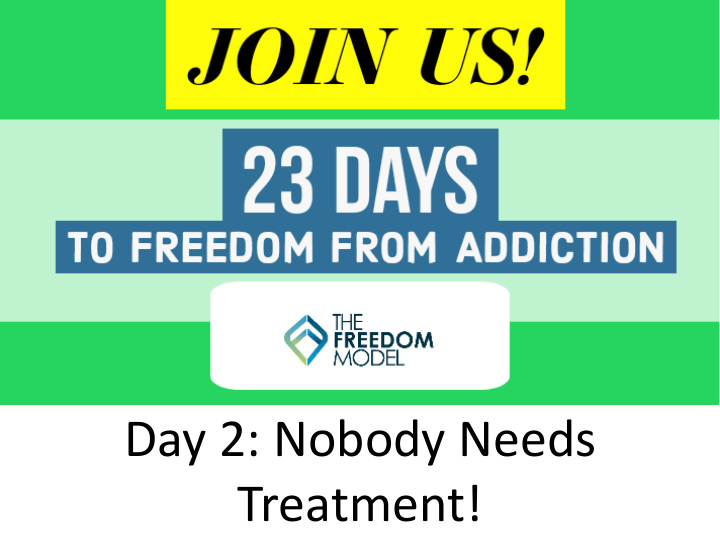



Day 2: Nobody Needs Treatment!
Activists say only 10% of people with addictions get treatment. Is that a bad thing?
How many people get over their drug and alcohol problems?
Currently Recovered from heroin for 1 or more years: • 88.8% in 2001/02 • 83% in 2012/13
How many people will eventually get over their drug and alcohol problems?
Lifetime cumulative probability estimates of dependence remission were: • 90.6% for alcohol • 97.2% for cannabis • 99.2% for cocaine Half of the cases of alcohol, cannabis and cocaine dependence remitted approximately 14, 6 and 5 years after dependence onset, respectively.
Lifetime cumulative probability estimates of remission were • 98.7% for sedatives • 98.3% for tranquilizers • 96.1% for opioids • 99.0% for stimulants Half of the cases of PDUD of sedatives, tranquilizers and opioids remitted approximately 5 years after onset, whereas half of the cases of stimulants dependence/abuse remitted approximately 4 years after onset (Fig. 1).
Does treatment make a difference?
National Longitudinal Alcohol Epidemiologic Survey 1992 42,862 people surveyed 4,585 Alcohol Dependence/Abuse 3,309 didn’t receive treatment Currently ”recovered” for 1 year or more: • 72.2% overall • 66.8% treated group • 74.2% untreated group
Canadian surveys of over 12,000 people. 3 out of 4 resolved alcohol problems without treatment Sobell, L. C., Cunningham, J. A., & Sobell, M. B. (1996). Recovery from alcohol problems with and without treatment: Prevalence in two population surveys. American Journal of Public Health, 86(7), 966 – 972.
20% of Soldiers in Vietnam developed heroin “addictions.” Less than 2% received treatment.
Vietnam Soldiers with heroin “addictions” • Half tried heroin again upon return. • 95% recovered in first year • 88% recovered in year 3 • 96% recovered in year 24 Robins, L. N. (1993). The sixth Thomas James Okey Memorial Lecture. Vietnam veterans’ rapid recovery from heroin addiction: A fluke or normal expectation? Addiction (Abingdon, England), 88(8), 1041 – 1054 .
Side note, regarding popular interpretation of Vietnam heroin addiction and recovery: “The argument that addiction in Vietnam was a response to war stress, and therefore remitted on exit from the Vietnam war theatre, is still frequently cited as though it were self-evident, because it sounds so plausible. Yet accepting this argument is difficult in the face of the facts. Heroin was so readily available in Vietnam that more than 80% were offered it, and usually within the week following arrival. Those who became addicted had typically begun use early in their Vietnam tour, before they were exposed to combat. Further, the dose response curve that is such a powerful causal argument did not apply: those who saw more active combat were not more likely to use than veterans who saw less , once one took into account their pre-service histories. (Those with pre-service antisocial behavior both used more drugs and saw more combat. Their greater exposure to combat was presumably because they had none of the skills that kept cooks, typists, and construction workers behind the lines.)” “when we asked men why they used heroin, they did not tell us that they were overcome by fear or stress. Rather they said it was enjoyable and made life in service bearable” Robins, L. N. (1993). The sixth Thomas James Okey Memorial Lecture. Vietnam veterans’ rapid recovery from heroin addiction: A fluke or normal expectation? Addiction (Abingdon, England), 88(8), 1041 – 1054.
Recommend
More recommend